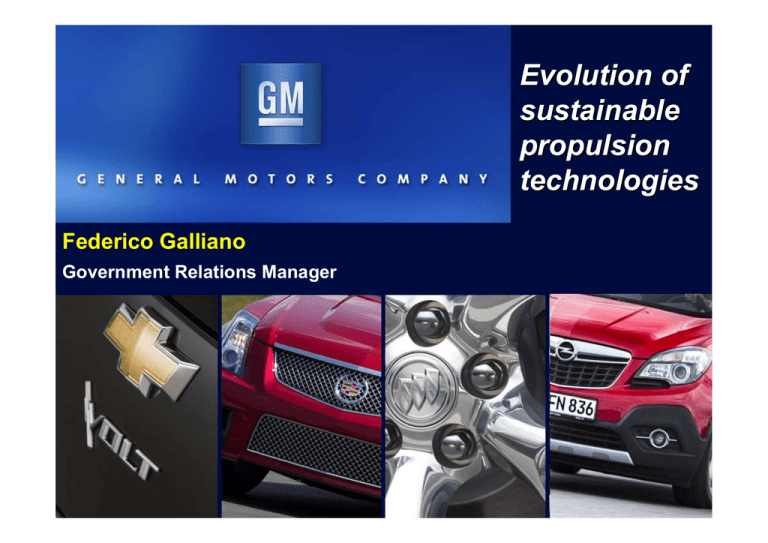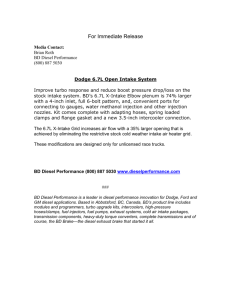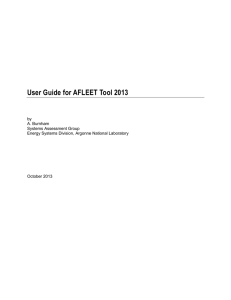Evolution of sustainable propulsion technologies
advertisement

Evolution of sustainable propulsion technologies Federico Galliano Government Relations Manager 1 Items List 9 Propulsion Technologies evolution 9 ICE Optimization 9 Hybrid vehicles 9 Electric vehicles 2 22 years to go from Euro1 to Euro6 Diesel engines Euro11992 Euro21996 Euro4Euro6- Euro5- 2005 2014 2009 Euro32000 Huge reduction in emissions leading to development and applications of new technologies to diesel engines (after treatment, common rail, engine management system, turbo-charging) 3 Sustainable Mobility Dilemma ENERGY SOURCES SHORT DISTANCES WATER LONG DISTANCES ENVIRONMENT AIR PASSENGERS TRANSPORT GOODS TRANSPORT To satisfythe mobility needs our Preserving resources to of satisfy generation the needs of future generations 4 Efficiency Electrification: enabler of further steps in efficiency improvement Displace Petroleum • Grid connection Hybridization Upper Bound Hybridization Conventional Upper Bound • EV Operation • Load Shifting • Regeneration • Stop / Start Improvements in Conventional Powertrain Technology Implementation 5 Gasoline engines - Current state of the Art Spark Spark Ignition Ignition Direct Injection Direct Injection Cam Cam Phasing, Phasing, Variable Variable Valve Valve Lift, Active Fuel Management Lift, Active Fuel Management Downsized Downsized SIDI SIDI Turbo Boosting Turbo Boosting Advanced Advanced Combustion Combustion 6 Diesel engines – Current State of the Art Advanced Advanced Boosting Boosting with with Small Displacement Small Displacement Cylinder Cylinder Pressure Pressure Sensing Sensing HP Turbo LP Turbo Diesel Diesel Particulate Particulate Filter Filter NO NOXX Aftertreatment Aftertreatment Oxidation Catalyst Porous Porous Cell Cell Wall Wall Urea Injection Particulate Filter SCR Urea NOx Catalyst 7 New 1.6-liter diesel engine powered by GM New family of state-of-the-art, fourcylinder, 1.6-liter diesel engines Class-leading refinement, high power/torque density Fuel consumption reduced by up to 10 percent Compliant with future Euro 6 emissions requirements 8 System Optimization in the Vehicle In a lighter vehicle, a smaller less powerful powertrain may be used Powertrain solutions solutions Powertrain These downsized onlypowertrains achievecan their full only achieve their still full potential, if combined combined benefit from the potential, if technology improvement with vehicle level with vehicle level optimizations such such optimizations as mass mass reductions reductions & & as aerodynamic aerodynamic improvements improvements Maintained Performance 9 DOWNSIZED TURBO GASOLINE ENGINE 42mpg = 17.9 km/l ECOFLEX TURBO DIESEL ENGINE Opel Astra EcoFlex 1.7L CDTI 99g/km CO2 Energy sources, paths, on-vehicle storage and vehicle propulsion systems Energy Resouce Conversion Oil (Conventional) Liquid Fuels & CNG Oil (Non Convent.) Biomass Energy Carrier Propulsion System Conventional ICE Gasoline / Diesel ICE Hybrid Syngas Electricity Plug – In Hybrid Coal Range Extender EV Renewables Hydrogen Electrification Natural Gas Battery Electric Nuclear Fuel Cell Electric 12 Alternative Fuels Source 1,81€ Gasoline Refinery Diesel Refinery CNG Natural Gas (Metano) LPG Refinery (GPL) Ethanol (E85) Biodiesel €/lt Influenced by tx 41% - indust price 59% - Taxes 1,71€ 47% - Indust price 53% - Taxes 0,99€ 80% - Indust. Price 20% - Taxes - TBC 0,87€ 80% - Indust. Price 20% - Taxes - TBC Canna da zucchero … NN Olio estratto da semi di girasole, soia, colza NN Emissions (PM/Nox) CO2 N. fuel pumps (Italy) Limitations 22,900 22,900 790 2,970 <10 13 Alternative Fuels Opel Astra Sports Tourer 140 Hp/130 Hp Ds Diesel 4,5 Lt/100 km 1,71 €/lt 3,8 €/50 km Reference Gasoline 6,1 Lt/100 km 1,81 €/lt 5,5 €/50 km 43% -8% LPG Ampera 8,1 Lt/100 km 0,87 €/lt 3,5 €/50 km 1 €/50 km 14 Gravimetric Energy Density (Wh/kg) Energy Density in Carriers Gasoline & Diesel vs batteries Gasoline Diesel H2 700 bar Ethanol Li-Ion Lead NiMH Volumetric Energy Density (Wh/I) 15 ee-Assist -Assist Technology Buick’s e-Assist Technology Mild Hybrid architecture based on: ¾State-of-the-art lithium-ion battery ¾High power Motor Generator Unit (BAS) ¾Real time energy optimizer ECU Features: Power Flow Display ¾Enhanced Start & Stop ¾Regenerative coasting/braking ¾Torque/power electrical assist ¾Electric launch 16 Cost Range and Cost 0 50 100 150 200 250 300 350 400 450 500 Range/km 17 Cost Range and Recharging Time 0 50 100 150 200 250 300 350 400 450 500 Range/km Î The same is valid for mass and volume 18 Typical Daily Mileage 25% 20% 80% of daily driving 50 km or less 15% 10% 5% 0% 0-1 2-4 5-10 11-20 21-50 51-100 > 100 km Source: Mobilität in Deutschland, 2002 19 Opel Ampera A Fully Capable Electric Vehicle 40–80 km Battery-electric driving Full usability: Performance and refueling like conventional vehicles 20 Reliability in Daily Use 21 Opel Ampera A Fully Capable Electric Vehicle Battery not greater than necessary Æ 4-seater + trunk Æ primary vehicle Opel as first German manufacturer of volume production electric vehicle Start of sales: End of 2011 22 Chevrolet Spark EV • This electric mini car utilizes some of the same cutting-edge electric power technology proven in the Chevrolet Volt. • Motor that delivers 130Hp and 542Nm for instant acceleration, 20kWh Li-Ion battery • Battery is backed by an 8-year/100,000mile limited warranty • It will be sold in USA, initially 80% re-charge in 20min with dedicated SAE Combo DC Fast Charge Full re-charge in 7 hours with AC 240V station 23 The Challenge of a New Technology 1983: Martin Cooper introduces first Motorola Mobile Dynatac 8000 «The Brick» 4000US$ - 1000 g «A portable Desk Phone» 2010: Steve Jobs introduces New Generation iPhone 300US$ - 135 g4 «A Smart Netbook integrated in a Mobile Case» 24 It is also the Challenge of Infrastructure 25



